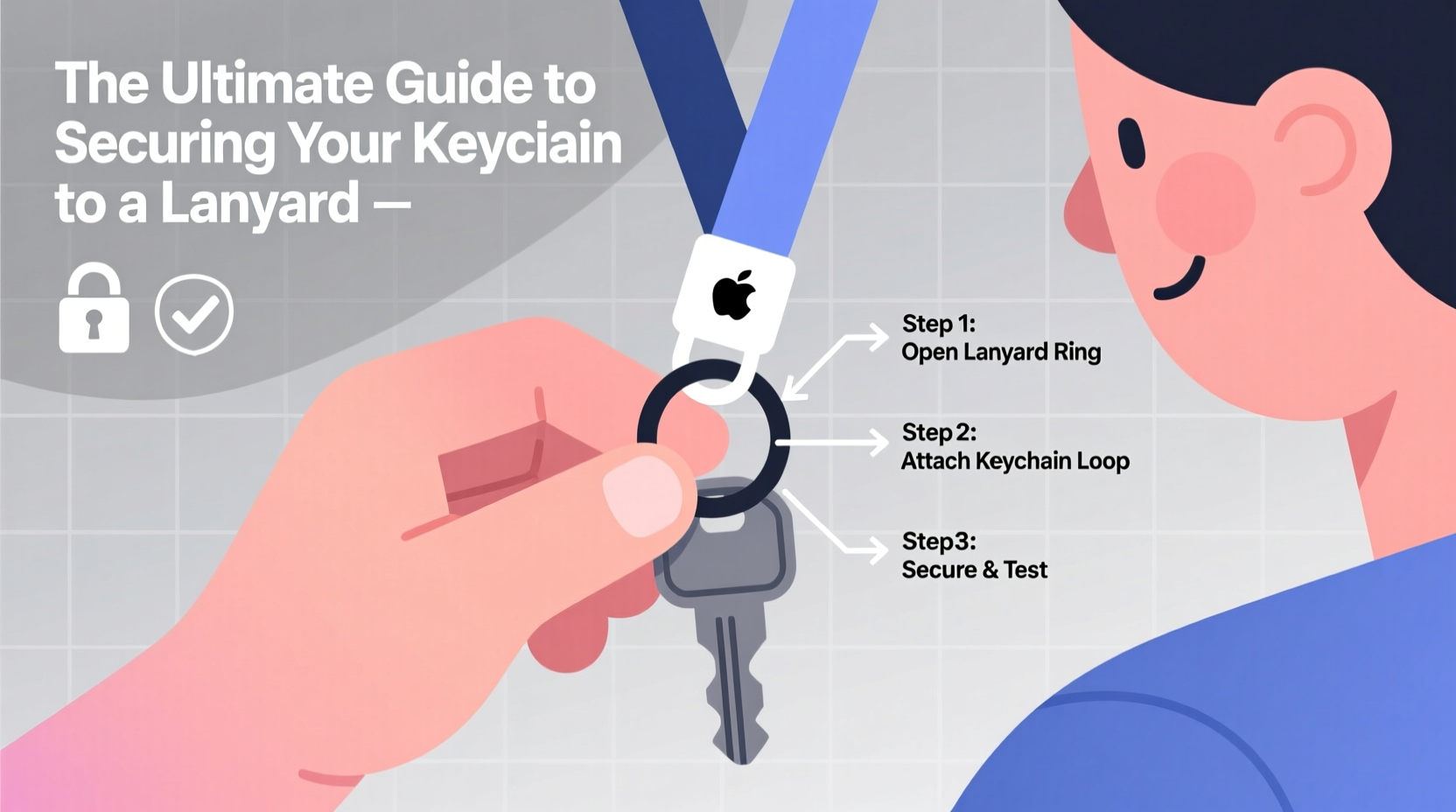Carrying keys on a lanyard offers convenience, accessibility, and style—but only if done correctly. A poorly attached keychain can slip off, get damaged, or even pose a safety risk during daily activities. Whether you're using a lanyard at work, school, travel, or events, ensuring your keys stay firmly in place is essential. This guide walks through best practices, tools, attachment methods, and real-world tips to keep your keychain secure and functional every day.
Why Secure Attachment Matters

A loose or improperly fastened keychain isn’t just inconvenient—it can lead to lost keys, compromised security, or damage to sensitive items like USB drives or fobs. In high-movement environments such as gyms, public transit, or crowded venues, an insecure connection increases the chance of detachment. Moreover, repeated tugging or swinging can wear down weak links over time, leading to sudden failures.
Security doesn’t mean sacrificing ease of access. The ideal setup allows quick removal when needed while remaining resistant to accidental pulls or snagging.
Essential Tools and Components
Not all lanyards and keychains are created equal. Understanding the parts involved helps you choose compatible, durable components.
- Lanyard End Fittings: Common types include bulldog clips, breakaway clasps, swivel hooks, and key rings. Choose based on usage environment (e.g., breakaways for safety in schools).
- Key Rings: Split rings are more secure than open O-rings; consider double-stacked split rings for added retention.
- Connectors: Use carabiners, lobster clasps, or quick-link connectors to bridge the gap between lanyard and keychain reliably.
- Reinforcement Sleeves: Rubber or silicone sleeves can prevent metal-on-metal abrasion that leads to premature failure.
“Over 60% of reported key losses stem from failed attachments, not theft or misplacement.” — James Roderick, Industrial Safety Consultant
Step-by-Step Guide to Secure Attachment
Follow this sequence to ensure maximum reliability and longevity:
- Select the Right Lanyard Type: Opt for one with a reinforced end fitting designed for weight-bearing (e.g., nylon webbing with a molded plastic clasp).
- Add a Secondary Connector: Attach a small stainless steel carabiner or lobster clasp directly to the lanyard’s terminal loop.
- Use a Double-Layered Key Ring: Replace flimsy single rings with two interlocked split rings to reduce rotation and slippage.
- Link Keys Securely: Thread each key onto the inner ring first, then close the outer ring around the connector from the lanyard.
- Test Under Stress: Simulate movement by shaking the lanyard vigorously and checking for looseness or wobbling connections.
- Apply a Retaining Sleeve (Optional): Slide a heat-shrink tube or rubber grommet over critical joints to dampen vibration and friction.
Do’s and Don’ts: Best Practices Compared
| Do’s | Don’ts |
|---|---|
| Use a breakaway clip in educational or healthcare settings | Attach keys directly to weak plastic loops without reinforcement |
| Choose corrosion-resistant materials like nickel-plated or titanium hardware | Overload the lanyard with heavy multi-key sets beyond its rated capacity |
| Inspect connections monthly for signs of wear or deformation | Ignore fraying on the lanyard strap near stitching points |
| Keep sharp key edges away from direct contact with fabric to prevent cuts | Use glue or adhesives to “secure” moving metal parts—this rarely works long-term |
Real-World Scenario: Office Worker’s Near-Miss
Sarah, a project manager at a tech firm, used her lanyard daily to carry office access keys, a USB drive, and personal keys. After three weeks of regular subway commutes, she noticed the split ring had begun to unwind slightly due to constant jostling. One morning, while rushing through a turnstile, the entire keychain detached unnoticed. It wasn’t until she reached her desk that she realized the USB containing client data was missing.
After retrieving the keys from lost-and-found (thanks to a colleague who found them), Sarah upgraded to a dual-split-ring system connected via a micro-carabiner. She also began inspecting her setup weekly. Since then, she hasn’t had a single incident—even during hectic travel days.
Checklist: Secure Keychain-Lanyard Setup
Before relying on your setup daily, verify these points:
- ✅ Lanyard material is rated for the combined weight of your keys and accessories
- ✅ Connection point uses a secure metal fastener (carabiner, clasp, or welded ring)
- ✅ Key ring is a tight-fitting split ring, preferably doubled
- ✅ No exposed sharp edges that could fray the lanyard
- ✅ Breakaway feature present if required by workplace policy
- ✅ Regular inspection schedule established (e.g., every Monday morning)
Frequently Asked Questions
Can I reuse old key rings safely?
Only if they show no signs of bending, stretching, or corrosion. Over time, repeated opening and closing weakens metal fatigue resistance. Replace any ring that feels loose or doesn't snap shut crisply.
Is a carabiner better than a simple hook?
Yes, especially for active users. Carabiners offer a locking mechanism (in screw-gate or auto-lock models) that prevents accidental disengagement. Even basic spring-loaded versions provide superior retention compared to open hooks.
How do I prevent my keys from rotating and tangling?
Use a swivel connector between the lanyard and keychain. This allows the keyring to spin independently, reducing twist buildup during movement. Pair it with flat-profile keys arranged neatly to minimize bulk.
Final Thoughts and Action Steps
Attaching a keychain to a lanyard may seem trivial, but doing it poorly invites avoidable risks. By selecting quality components, applying proven attachment techniques, and maintaining vigilance through routine checks, you transform a simple accessory into a dependable tool.
Your keys represent access—to your home, vehicle, workplace, and digital devices. Treat their transport with the same care you’d give any valuable item. Re-evaluate your current setup today. Upgrade weak links, eliminate hazards, and build a system that works seamlessly with your lifestyle.









 浙公网安备
33010002000092号
浙公网安备
33010002000092号 浙B2-20120091-4
浙B2-20120091-4
Comments
No comments yet. Why don't you start the discussion?